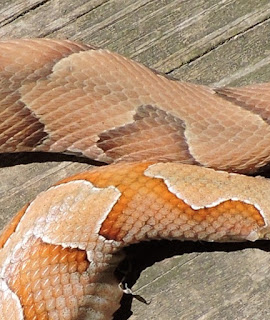 |
| Old skin off the back half - REK |
 |
| Rat snake shed, eye covered - REK |
 |
| Old above, peeled new skin below |
When I picked up the snake several hours later some of the skin came off on my fingers. I peeled some of the outer skin off the back half, leaving the bright shiny new skin below. The beauty of it made me further regret the unavoidable sacrifice of its life.
Note:
I would not advocate the killing of any snake unless it is a potential danger to humans or their animals. Sometimes it is impossible to safely remove a snake. It is illegal to sell a non-game animal skin.
MDC Editor's note from Conservationist Magazine, August, 2000:
"We have a controversy among several of us about whether it is legal or illegal to kill snakes in Missouri?"
Garvis Myers, Festus
"The Wildlife Code of Missouri is permissive, in that it details what wildlife related activities are allowed. Any wildlife-related activities not included in the Wildlife Code are, therefore, not permitted. This includes the killing of snakes. However, the Code does permit Missourians to protect their property and family from immediate harm from wildlife, which means that under certain circumstances venomous snakes may be killed to protect people in the immediate area. Most snakes are not venomous, and the few venomous snakes you may encounter can usually be avoided."